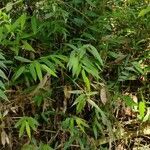Culms to 14 m, 7–8 cm in diam., apically slightly drooping; internodes 30–35 cm, initially white powdery, lower internodes slightly flexuose, basal internodes often with 2 or 3 faint yellow stripes; wall very thick; nodes with rings of gray-white silky hairs below and above sheath scar, basal nodes with short aerial roots; branching from ca. 4th node up. Branches many, clustered, central 3 dominant. Culm sheaths deciduous, usually less than 1/2 as wide as long at base, leathery, densely stiffly dull brown strigose, apex subtruncate; auricles unequal, not slanted downward along sheath margin, 1.5–2.5 × 1.3–1.5 cm, one tall and ovate, one low and oblong, undulate, wrinkled; oral setae long, undulate; ligule ca. 5 mm, dentate, shortly fimbriate; blade erect, slightly asymmetrical, broadly triangular, base slightly narrowed and joined to auricles for ca. 1 cm, nearly 3/4 width of sheath apex, both surfaces stiffly pale hairy, apex acutely acuminate. Leaf blade broadly linear or linear-lanceolate, 15–19 × 1.4–1.7 cm, abaxially pale gray, densely villous, adaxially deep green, glabrous. Inflorescence unknown from China.
More
A thick walled tufted bamboo. It grows to about 20 m tall. It is almost un-branched near the base but branches higher up. The nodes are slightly thickened. The internodes are 40-65 cm long and 5-10 cm wide. They have a white ring around the node. They are grey-green at maturity. The culm sheath is 10-25 cm long and 15-25 cm wide. The leaves have leaf stalks. The leaves are 15-25 cm long and 2-4 cm wide. They are narrow and sword shaped. They are hairy underneath. Young shoots are green with yellow stripes. Plants may take 25-40 years to flower.
Mixed deciduous forest in plains, valleys, and along streams, up to elevations of 1,500 metres. Common on flat alluvial land along streams in the mixed deciduous forests and along the banks of dry water-courses in Myanmar.
More
A tropical and subtropical plant. It grows in Nepal at 200-1200 m altitude. It grows in moist soils near rivers. It grows up to 1500 m altitude in Bangladesh. In the Cairns Botanical Gardens. In Yunnan.

